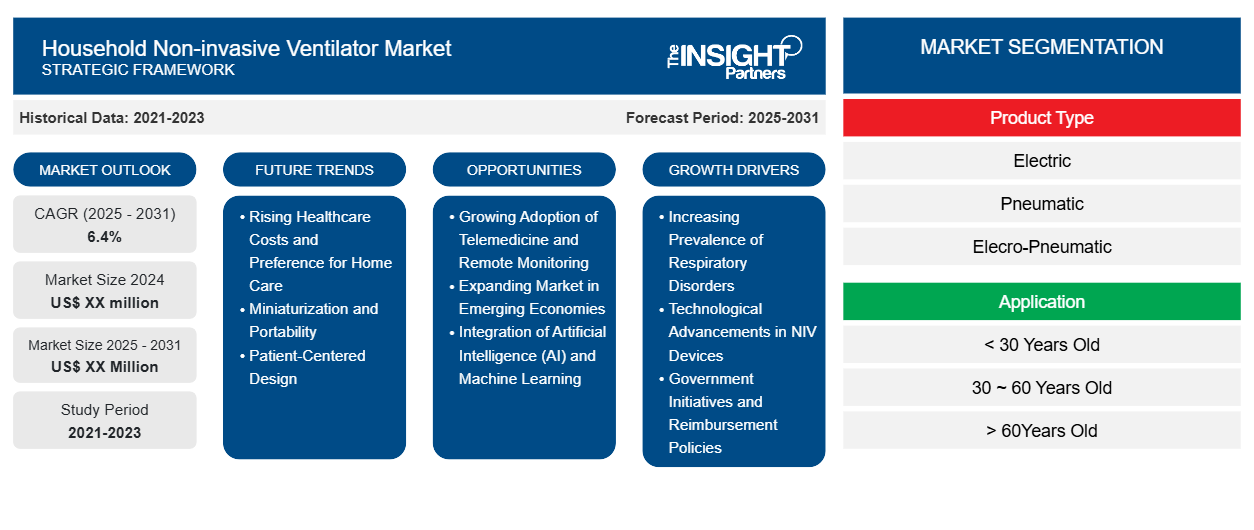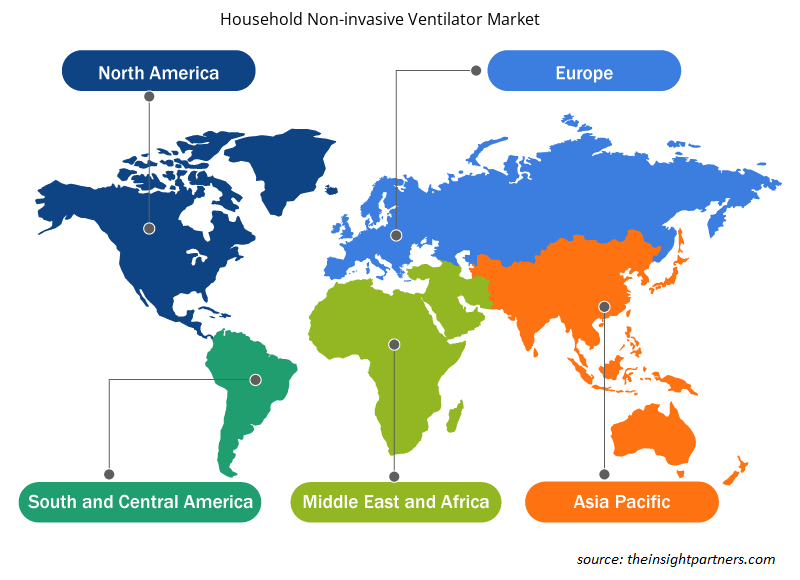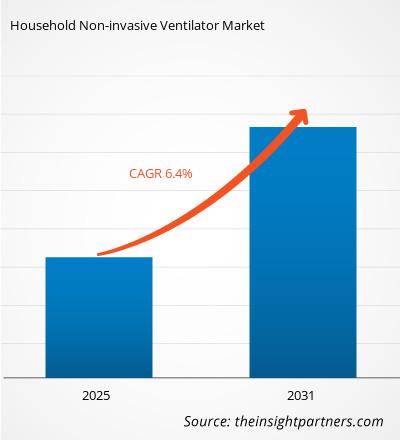من المتوقع أن يسجل سوق أجهزة التنفس الصناعي غير الجراحية المنزلية معدل نمو سنوي مركب بنسبة 6.4٪ من عام 2025 إلى عام 2031، مع توسع حجم السوق من XX مليون دولار أمريكي في عام 2024 إلى XX مليون دولار أمريكي بحلول عام 2031.
يُقسّم التقرير حسب نوع المنتج (كهربائي، هوائي، كهربائي هوائي). كما يُقدّم تحليلاً قائماً على التطبيق (أقل من 30 عاماً، من 30 إلى 60 عاماً، أكبر من 60 عاماً). ويُفصّل التحليل العالمي على المستوى الإقليمي والدولي الرئيسي. ويُقدّم التقرير القيمة بالدولار الأمريكي للتحليل والقطاعات المذكورة أعلاه.
غرض التقرير
يهدف تقرير "سوق أجهزة التنفس الصناعي المنزلية غير الجراحية" الصادر عن شركة "ذا إنسايت بارتنرز" إلى وصف المشهد الحالي والنمو المستقبلي، وأهم العوامل المحفزة، والتحديات، والفرص المتاحة. وسيوفر هذا التقرير رؤى ثاقبة لمختلف أصحاب المصلحة في قطاع الأعمال، مثل:
- مزودي التكنولوجيا/المصنعين: لفهم ديناميكيات السوق المتطورة ومعرفة فرص النمو المحتملة، وتمكينهم من اتخاذ قرارات استراتيجية مستنيرة.
- المستثمرون: إجراء تحليل شامل للاتجاهات فيما يتعلق بمعدل نمو السوق، والتوقعات المالية للسوق، والفرص المتاحة عبر سلسلة القيمة.
- الهيئات التنظيمية: لتنظيم السياسات ومراقبة الأنشطة في السوق بهدف تقليل الانتهاكات والحفاظ على ثقة المستثمرين ودعم سلامة السوق واستقرارها.
تجزئة سوق أجهزة التنفس الصناعي المنزلية غير الجراحية
نوع المنتج
- كهربائي
- هوائي
- كهربائي هوائي
طلب
- أقل من 30 سنة
- 30 إلى 60 عامًا
- > 60 سنة
قم بتخصيص هذا التقرير ليناسب متطلباتك
ستحصل على تخصيص لأي تقرير - مجانًا - بما في ذلك أجزاء من هذا التقرير، أو تحليل على مستوى الدولة، وحزمة بيانات Excel، بالإضافة إلى الاستفادة من العروض والخصومات الرائعة للشركات الناشئة والجامعات
سوق أجهزة التنفس الصناعي المنزلية غير الجراحية: رؤى استراتيجية

- احصل على أهم اتجاهات السوق الرئيسية لهذا التقرير.ستتضمن هذه العينة المجانية تحليل البيانات، بدءًا من اتجاهات السوق وحتى التقديرات والتوقعات.
عوامل نمو سوق أجهزة التنفس الصناعي المنزلية غير الجراحية
- تزايد انتشار اضطرابات الجهاز التنفسي: هناك ارتفاع في حالات اضطرابات الجهاز التنفسي، مثل مرض الانسداد الرئوي المزمن، وانقطاع التنفس أثناء النوم، والأمراض العصبية العضلية، نتيجةً لتزايد شيخوخة السكان، والتدهور البيئي، وتغير أنماط الحياة. وقد نشأ الطلب المتزايد على أجهزة التهوية غير الغازية بين المرضى المزمنين من الحاجة المتزايدة لإدارة المرضى الذين يحتاجون إلى دعم تنفسي طويل الأمد في المنزل.
- التطورات التكنولوجية في أجهزة التهوية غير الغازية: ساهم التطور في التصميم في جعل أجهزة التهوية غير الغازية أصغر حجمًا وأكثر كفاءةً وسهولةً في الاستخدام، مما أتاح انتشارًا واسعًا في المنازل. وتزيد المزايا المُحسّنة، مثل سهولة الحركة، وسهولة الحمل، وسهولة الاستخدام، والتشغيل الهادئ، والراحة، من جاذبية أجهزة التهوية غير الغازية. كما أن الاتصال بالهاتف المحمول من خلال تطبيقات المراقبة عن بُعد يُعزز تفاعل المريض ويسهل إدارته، مما يجعل التهوية غير الغازية خيارًا عمليًا أكثر.NIV Devices: Advances in design have made the non-invasive ventilators smaller, efficient, and user-friendly, thus allowing widespread adoption into the home setting. Improved advantages, such as mobility, portability, ease of use, quiet operation, and comfort increase attractiveness toward NIV devices. Mobile connectivity with apps on remote monitoring further heighten patient activation and ease of management whereby NIV becomes a more practical option.
- المبادرات الحكومية وسياسات السداد: تُقدم بعض الدول دعمًا لمعدات الرعاية المنزلية، بما في ذلك أجهزة التنفس الصناعي غير المباشر (NIV)؛ وقد تحسنت سياسات السداد الأخرى في العديد من المناطق، مما أتاح توفير أجهزة التنفس الصناعي غير المباشر بأسعار معقولة لفئة أكبر من المرضى. تشجع هذه السياسات مُقدمي الخدمات الصحية والمرضى على التوجه نحو حلول أجهزة التنفس الصناعي المنزلية.
اتجاهات مستقبل سوق أجهزة التنفس الصناعي المنزلية غير الجراحية
- ارتفاع تكاليف الرعاية الصحية وتفضيل الرعاية المنزلية: مع تزايد العبء على الأنظمة الصحية، وخاصة في الاقتصادات النامية، يزداد الضغط على الرعاية المنزلية سعياً لخفض تكاليف دخول المستشفى ورعاية المرضى الداخليين. تُعدّ أجهزة التهوية غير الغازية خياراً اقتصادياً للمرضى الذين يحتاجون إلى مساعدة تنفسية طويلة الأمد ويرغبون في إدارة حالتهم في بيئة منزلية بدلاً من المستشفى.
- التصغير وسهولة الحمل: إن التوجه نحو التصغير يجعل أجهزة NIV أكثر سهولة في الحمل والتنقل، بالإضافة إلى كونها غير ظاهرة، ومريحة الاستخدام. ويفضل معظم المرضى اليوم بشكل متزايد الأجهزة الصغيرة وخفيفة الوزن التي يسهل نقلها للاستخدام المنزلي. وينجذب معظم المرضى إلى هذا التوجه الجديد، الذي يوفر وسيلة أفضل وأقل تدخلاً للاستخدام طويل الأمد.
- تصميم مُركّز على المريض: ثمة حاجة ماسة لتطوير أجهزة NIV لتسهيل استخدامها وراحة المرضى. تُحسّن تصاميم الأقنعة المُحسّنة، وتقنيات خفض الضوضاء، وغيرها من الميزات المُريحة تجربة المستخدمين بشكل كبير. تُركّز الشركات على جعل أجهزة NIV الخاصة بها أكثر سهولة في الاستخدام والتعلّم، وذلك لزيادة التزام المرضى بها.
فرص سوق أجهزة التنفس الصناعي المنزلية غير الجراحية
- تزايد اعتماد التطبيب عن بُعد والمراقبة عن بُعد: وبالتالي، أصبح التطبيب عن بُعد وسيلةً سريعةً لإدارة الرعاية الصحية، وخاصةً الأمراض المزمنة. تتيح وظائف المراقبة عن بُعد في أجهزة التهوية غير الغازية (NIV) لمقدمي الرعاية الصحية مراقبة حالة تنفس المرضى آنيًا، مما يتيح لهم إجراء تعديلاتٍ فورية على العلاج دون الحاجة إلى زيارة المستشفى. وهذا بدوره يفتح المجال أمام المصنّعين لابتكار حلولٍ أكثر تكاملًا تُحسّن نتائج الرعاية للمرضى دون زيادة العبء على أنظمة الرعاية الصحية.
- توسع السوق في الاقتصادات الناشئة: يُسهم التقدم في أنظمة الرعاية الصحية في الأسواق الناشئة، مثل آسيا والمحيط الهادئ وأمريكا اللاتينية وأجزاء من أفريقيا، في زيادة الطلب على حلول تنفسية منخفضة التكلفة وفعالة في آنٍ واحد. ويمثل تزايد الوعي بأمراض الجهاز التنفسي المزمنة وتحسين الوصول إلى خدمات الرعاية الصحية فرصةً كبيرةً لمصنعي أجهزة التنفس الصناعي غير الغازية لتوسيع نطاق انتشارهم الجغرافي في هذه المناطق.
- دمج الذكاء الاصطناعي والتعلم الآلي: يُمثل دمج الذكاء الاصطناعي والتعلم الآلي في أجهزة التنفس الصناعي غير المباشر (NIV) إمكانيةً واعدةً. إذ يُمكن لخوارزميات الذكاء الاصطناعي تحسين إعدادات أجهزة التنفس الصناعي، والتنبؤ بتفاقم الأعراض، وتقديم علاج مُخصص بناءً على بيانات آنية. يُحسّن هذا الابتكار دقة وكفاءة العلاج، ويُتيح المجال لأنظمة تنفس صناعي غير مباشر (NIV) أكثر ذكاءً وتكيفًا.
رؤى إقليمية حول سوق أجهزة التنفس الصناعي المنزلية غير الجراحية
قام محللو شركة إنسايت بارتنرز بشرح شامل للاتجاهات الإقليمية والعوامل المؤثرة في سوق أجهزة التنفس الصناعي المنزلية غير الباضعة خلال فترة التوقعات. ويناقش هذا القسم أيضًا قطاعات سوق أجهزة التنفس الصناعي المنزلية غير الباضعة ومناطقها الجغرافية في أمريكا الشمالية، وأوروبا، وآسيا والمحيط الهادئ، والشرق الأوسط وأفريقيا، وأمريكا الجنوبية والوسطى.

- احصل على البيانات الإقليمية المحددة لسوق أجهزة التنفس الصناعي غير الغازية المنزلية
نطاق تقرير سوق أجهزة التنفس الصناعي المنزلية غير الجراحية
| سمة التقرير | تفاصيل |
|---|---|
| حجم السوق في عام 2024 | XX مليون دولار أمريكي |
| حجم السوق بحلول عام 2031 | XX مليون دولار أمريكي |
| معدل النمو السنوي المركب العالمي (2025 - 2031) | 6.4% |
| البيانات التاريخية | 2021-2023 |
| فترة التنبؤ | 2025-2031 |
| القطاعات المغطاة | حسب نوع المنتج
|
| المناطق والدول المغطاة | أمريكا الشمالية
|
| قادة السوق وملفات تعريف الشركات الرئيسية |
|
كثافة الجهات الفاعلة في سوق أجهزة التنفس الصناعي المنزلية غير الجراحية: فهم تأثيرها على ديناميكيات الأعمال
يشهد سوق أجهزة التنفس الصناعي المنزلية غير الباضعة نموًا متسارعًا، مدفوعًا بتزايد طلب المستخدمين النهائيين نتيجةً لعوامل مثل تفضيلات المستهلكين المتطورة، والتقدم التكنولوجي، وزيادة الوعي بفوائد المنتج. ومع تزايد الطلب، تعمل الشركات على توسيع عروضها، والابتكار لتلبية احتياجات المستهلكين، والاستفادة من الاتجاهات الناشئة، مما يُعزز نمو السوق.
تشير كثافة اللاعبين في السوق إلى توزيع الشركات العاملة في سوق أو قطاع معين. وتشير إلى عدد المنافسين (اللاعبين في السوق) الموجودين في سوق معين نسبةً إلى حجمه أو قيمته السوقية الإجمالية.
الشركات الرئيسية العاملة في سوق أجهزة التنفس الصناعي غير الجراحية المنزلية هي:
- ريس ميد
- تيجين فارما
- ديفيلبيس للرعاية الصحية
- فيليبس
- لوينشتاين الطبية
إخلاء المسؤولية : الشركات المذكورة أعلاه ليست مرتبة بأي ترتيب معين.

- احصل على نظرة عامة على أهم اللاعبين الرئيسيين في سوق أجهزة التنفس الصناعي غير الجراحية المنزلية
نقاط البيع الرئيسية
- التغطية الشاملة: يغطي التقرير بشكل شامل تحليل المنتجات والخدمات والأنواع والمستخدمين النهائيين لسوق أجهزة التنفس الصناعي غير الجراحية المنزلية، مما يوفر صورة شاملة.
- تحليل الخبراء: تم تجميع التقرير على أساس الفهم العميق لخبراء الصناعة والمحللين.
- المعلومات الحديثة: يضمن التقرير أهمية الأعمال التجارية بسبب تغطيته للمعلومات الحديثة واتجاهات البيانات.
- خيارات التخصيص: يمكن تخصيص هذا التقرير لتلبية متطلبات العملاء المحددة وتلبية استراتيجيات العمل بشكل مناسب.
لذا، يُمكن أن يُساعد تقرير البحث حول سوق أجهزة التنفس الصناعي المنزلية غير الباضعة في تمهيد الطريق لفهم سيناريوهات هذه الصناعة وآفاق نموها. ورغم وجود بعض المخاوف المُبررة، إلا أن فوائد هذا التقرير الإجمالية تفوق عيوبه.
- التحليل التاريخي (سنتان)، سنة الأساس، التوقعات (7 سنوات) مع معدل النمو السنوي المركب
- تحليل PEST و SWOT
- حجم السوق والقيمة / الحجم - عالمي، إقليمي، بلد
- الصناعة والمنافسة
- مجموعة بيانات إكسل
التقارير الحديثة
شهادات العملاء
سبب الشراء
- اتخاذ قرارات مدروسة
- فهم ديناميكيات السوق
- تحليل المنافسة
- رؤى العملاء
- توقعات السوق
- تخفيف المخاطر
- التخطيط الاستراتيجي
- مبررات الاستثمار
- تحديد الأسواق الناشئة
- تحسين استراتيجيات التسويق
- تعزيز الكفاءة التشغيلية
- مواكبة التوجهات التنظيمية




















 احصل على عينة مجانية ل - سوق أجهزة التنفس الصناعي المنزلية غير الجراحية
احصل على عينة مجانية ل - سوق أجهزة التنفس الصناعي المنزلية غير الجراحية